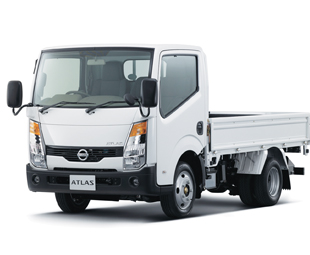Goodbye Nissan Diesel, hello UD Trucks Corporation!

As reported in FOCUS last month, Japanese truck manufacturer Nissan Diesel Motor Company has changed its corporate identity: to UD Trucks Corporation. Effective from 1 February 2010, the new name reflects Nissan Diesel’s long-standing practice in other parts of the world of branding and badging many of its vehicles “UD”.
Initially, the letters “UD” referred to a vehicle’s uniflow diesel engine based on the two-stroke combustion process and Roots-type scavenging blower. Later, when four-cycle technology was adopted, “UD” became associated with the term “ultimate dependability”. Either way, “UD” has always been linked with Nissan Diesel. Several Nissan Diesel offshore marketing operations were already operating under the UD corporate identity long before the announcement, so the change has little potential to disrupt company sales or communication strategies.
Nissan Diesel was first established in 1935 as Nihon Diesel Industries, specialising in the manufacture of truck and diesel engines. In 1950, a long association with Nissan Motor Company led to Nissan’s acquisition of an equity shareholding in Nihon Diesel Industries. In 1999, French car maker Renault bought control of Nissan and, by default, its interests in Nissan Diesel. The relatively small – in global terms – Japanese truck maker was destined to spend some time languishing in the light vehicle grouping headed by Renault with no obvious linkage to its truck department, control of which had been handed to Volvo AB following Renault’s buy-in to that company in 2000.
All that changed on 21 March 2006, when Volvo AB purchased a 13% controlling stake in Nissan Diesel out of the Nissan Motor shareholding. By 19 February 2007, the Swedish manufacturer had begun the process of raking in the balance of Nissan Diesel shares with a view to making it a wholly-owned subsidiary. Notwithstanding the obvious benefits of bringing Nissan Diesel under the Volvo AB umbrella, this decision was undoubtedly influenced by the working relationship Volvo had established in 1985 with China’s Dongfeng Motor Corporation. More recently, Nissan Diesel had taken over responsibility for marketing Volvo trucks in Japan, further cementing links between the two brands. Against this background, the present name change can be seen as a move to distance the truck maker from Nissan, positioning it more squarely in the heavy-duty alliance made up of Volvo, Renault Trucks and Mack, with Samsung and Dongfeng on the fringes.
Precisely how UD Trucks Corporation will interact with its siblings in the wider Renault-Nissan-Volvo family is not yet clear. The supply of light truck/MCV product to Nissan for sale under its Cabstar badge is just one aspect of the complex relationship hanging in the balance. The Cabstar name was once the exclusive property of Nissan Motor Company and, when Nissan Diesel could not supply Nissan Motors with the products it wanted for this brand, vehicles were sourced from Isuzu Motors.
In the February issue of Global Focus, we provided details of the latest Nissan Cabstar variant, the NT400, now going into production at China’s Zhengzhou Nissan plant. Readers were told of the Cabstar/Atlas range’s potential to dominate the global market for narrow- and wide-cab light forward-control/cab-over diesel-powered trucks from 1.5 to 5.4 t GVM, with power outputs up to 150 hp (112 kW). Only recently, Nissan Motors announced its intention to more effectively exploit the global light-truck niche market, aiming at doubling its light-commercial-derived income by 2012. Presumably, the latest Cabstar will be its flagship product. Although, on the UD Trucks website, the Cabstar NT400 is sold in Japan as a UD Condor, it is not clear if UD played any role in developing or manufacturing the product or is expected to contribute towards this process in future.
PACCAR launches MX engine state-side
Since 2006, Global Focus has been tracking PACCAR’s global strategy of using in-house branded diesel engines. Plans to extend the availability of European subsidiary DAF MX 12.9 l and PR 9.2 l power units to PACCAR’s American Peterbilt and Kenworth ranges were developed around intentions to establish a factory in Columbus, Mississippi, where these engines would be built. European MX and PR engines already carry PACCAR name plates, but the strategy has now been extended to give PACCAR branding and designations to smaller-displacement Cummins engines powering the group’s lighter payload products.
However, because of a sharp drop in truck sales during 2009, PACCAR has delayed commissioning the Columbus plant. Plans to offer these engines as part of the group’s North American market products have nevertheless gone ahead with units sourced from European manufacturers. Towards the end of January, PACCAR announced the MX engine’s debut in Kenworth and Peterbilt trucks to coincide with the arrival of summer. The United States (US) specification will include a power range of 380 to 485 hp (285 to 360 kW), torque outputs of up to 1 750 lb-ft (2 375 Nm), selective catalytic reduction, exhaust gas recirculation and EPA 2010 emissions compliance. DAF’s MX design features include a compacted graphite iron engine block and cylinder head, electronically-managed high-pressure fuel injection, rear-mounted timing gears and integral engine brakes. More than 125 000 MX engines have been fitted to DAF trucks since PACCAR first introduced its new strategy and variants have been developed to comply with Euro 4 and Euro 5 emissions levels.
PACCAR’s Kenworth and Peterbilt brands have long histories as standard American trucks, using drive-line aggregates bought in from Cummins, Caterpillar, Detroit Diesel, Eaton/Fuller, Arvin Meritor and others. In recent times, US truck builders have recognised the benefits of vertically integrating product specifications, particularly in the form of increased brand differentiation and after-market profitability. However, because operators have traditionally derived significant cost and availability benefits from highly rationalised parts and service sourcing, this trend has not proved popular. Nevertheless, foreign-owned concerns such as Freightliner and Mack have endorsed the new policy, with domestically-owned PACCAR and Navistar International following suit. Component manufacturers have, in turn, formed closer relationships with individual vehicle builders, so the trend towards more differentiated product now seems firmly established.
Cummins continues with Chrysler
Typical of the type of relationship referred to in the previous item is the one recently renewed between Cummins and the reconstituted Chrysler Group. Since 1989, Cummins has supplied more than 1.7 million diesel engines for fitment in Dodge Ram heavy-duty pick-ups and, in early February, it was announced that this arrangement will continue under the new Fiat-led Chrysler regime. Without the Dodge prefix, Ram has since become the stand-alone brand for Chrysler’s full-size US pick-up range.
The engine specification supplied in terms of the 1989 agreement was a 5.9 l unit developing 160 hp (119 kW) and producing 400 lb-ft (542 Nm) of torque. The latest 6.7 l turbo-diesel unit fitted to the new Ram launched in 2009 delivers outputs of
350 hp (261 kW) and 650 lb-ft (881 Nm), with a claimed 90% reduction in exhaust emissions when compared to the original specification. In 2007, the Chrysler-Cummins combination reached EPA 2010 emission standards three years ahead of its legal implementation.
Despite a widely-held perception that the US market does not favour diesel-powered light vehicles, this is certainly not the case when it comes to heavier pick-ups. The Chrysler-Cummins relationship is one example of this. Another is the recently terminated agreement between Navistar International and Ford, whereby Navistar agreed to supply Power Stroke diesel engines to Ford for its F-series super-duty pick-ups. This supply contract ran from 1982 until the end of 2009, reportedly accounting for 7% of Navistar’s 2008 revenue and 44% of its total engine production volume. Following a settled warranty dispute, the loss of this contract led to the closing of Navistar’s Indianapolis engine and casting plant.
Global FOCUS is a monthly update of international news relating to the commercial vehicle industry. It is compiled exclusively for FOCUS by Frank Beeton of Econometrix.
Published by
Focus on Transport
focusmagsa




